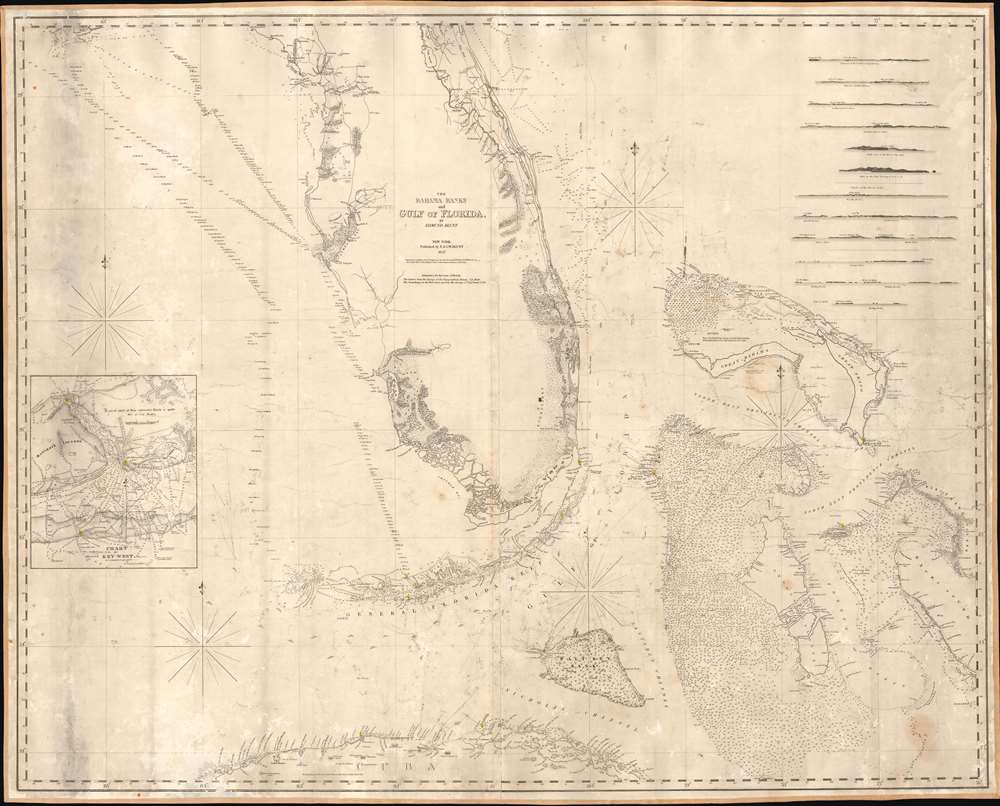This item has been sold, but you can get on the Waitlist to be notified if another example becomes available, or purchase a digital scan.
1847 Blunt Nautical Chart of Florida and the Bahamas
Florida-blunt-1847
Title
1847 (dated) 40 x 50 in (101.6 x 127 cm) 1 : 910000
Description
A Civil War Blockade Runner's Notes?
This chart features copious annotations relating to travel in the region that lead us to believe this chart was used by a Confederate Civil War blockade runner. The annotations are dated only once, on a note appearing in the Gulf of Mexico in 1861. This, and the course of the ship, up and down the east coast, to the Bahamas, passing into notorious smugglers dens like Gun Cay, Great Isaac Cay, and Elbow Key to Matazanas, Cuba, and into the Gulf, lead us to believe the annotations were made by a Confederate blockade runner. In addition, the annotator notably avoids Union strongholds like Fort Dallas (near modern day Miami) and Key West. The navigator also avoids the complications of Havana in favor of Matazanas, a sugar-trading slave-holding city with deep ties to the Confederacy. Throughout there are hard-to-read time-stamps, possibly noting the sightings of Union blockade ships. Between the date and the routes taken, we believe it is highly likely we are looking at a blockade runner smuggling rum, medical supplies, weapons, and other goods from Cuba to the Confederacy.Key West
An inset in the lower left quadrant focuses on Key West and the surrounding reefs. Around this time wrecking - the practice of salvaging from shipwrecks - had turned Key West into the richest city in Florida. Blunt attributes his inset of Key West to George Gauld, a late 18th century British naval surveyor who produced several extensive surveys of the area.Blueback Charts
Blueback nautical charts began appearing in London in the late 18th century. Bluebacks, as they came to be called, were privately published large format nautical charts known for their distinctive blue paper backing. The backing, a commonly available blue manila paper traditionally used by publishers to wrap unbound pamphlets, was adopted as a practical way to reinforce the low-quality paper used by private chart publishers in an effort to cut costs. That being said, not all blueback charts are literally backed with blue paper. The earliest known blueback charts include a 1760 chart issued by Mount and Page, and a 1787 chart issued by Robert Sayer. The tradition took off in the early 19th century, when British publishers like John Hamilton Moore, Robert Blachford, James Imray, William Heather, John William Norie, Charles Wilson, David Steel, R. H. Laurie, and John Hobbs, among others, rose to dominate the chart trade. Bluebacks became so popular that the convention was embraced by chartmakers outside of England, including Americans Edmund March Blunt and George Eldridge, as well as Scandinavian, French, German, Russian, and Spanish chartmakers. Blueback charts remained popular until the late 19th century, when government subsidized organizations like the British Admiralty Hydrographic Office and the United States Coast Survey, began issuing their own superior charts on high quality paper that did not require reinforcement.Publication History and Census
This chart, in the preset iteration, was first published by E. and G. W. Blunt in 1844, although precursor charts date back at least until 1822. Subsequent updates appeared annually through the 1850s. The present example was issued in 1847. Cartographically, the map is derived from the topographical surveys of Colonel Abert of the U.S. Topographical Bureau and hydrography of U.S. Navy Surveyor Commander Powell. The Key West inset is based on surveys by George Gauld. Blunt's chart represents the pinnacle of nautical mapping in and around the Florida peninsula until the work of the U.S. Coast Survey in the 1850s. Scarce.Cartographer
Edmund March Blunt (June 20, 1770 - 1862) was an American navigator, bookseller, chartmaker, and cartographer based in Newburyport, Massachusetts. Blunt was born in Portsmouth, New Hampshire in 1770. In 1796, along with the nominal assistance of prominent navigator Captain Lawrence Furlong, Blunt published The American Coast Pilot, one of the most important published works on American navigation. Although much of the work was plagiarized from British publications, the Coast Pilot was an immediate popular success. In response to the popularity of his work, Blunt published 21 subsequent editions, each with important updates and revisions. The first edition to contain map plates was printed in 1804. Following a fire that destroyed his offices at The Sign of the Bible in 1811, Blunt moved his business to New York and opened a new shop, The Sign of the Quadrant. His sons Edmund Jr. (1799 - 1866) and George William (1802 - 1878), joined the firm in 1824 and eventually took over the family business, renaming the firm 'E. and G. W. Blunt'. They both produced their own nautical books, charts, and instruments, as well as republished their father’s work. In 1830, Edmund accepted a position under Ferdinand Hassler at the United States Office of the Coast Survey. Much of Blunt's original work eventually found its way into U.S. Coast Survey Publications. George closed the firm in 1872 and sold the plates and chart copyrights to the U.S. Coast Survey and the U.S. Navy Hydrographic Office. Due to the quality and detail of Blunt's work, revised editions of his most important charts were republished well into the 1880s. More by this mapmaker...

